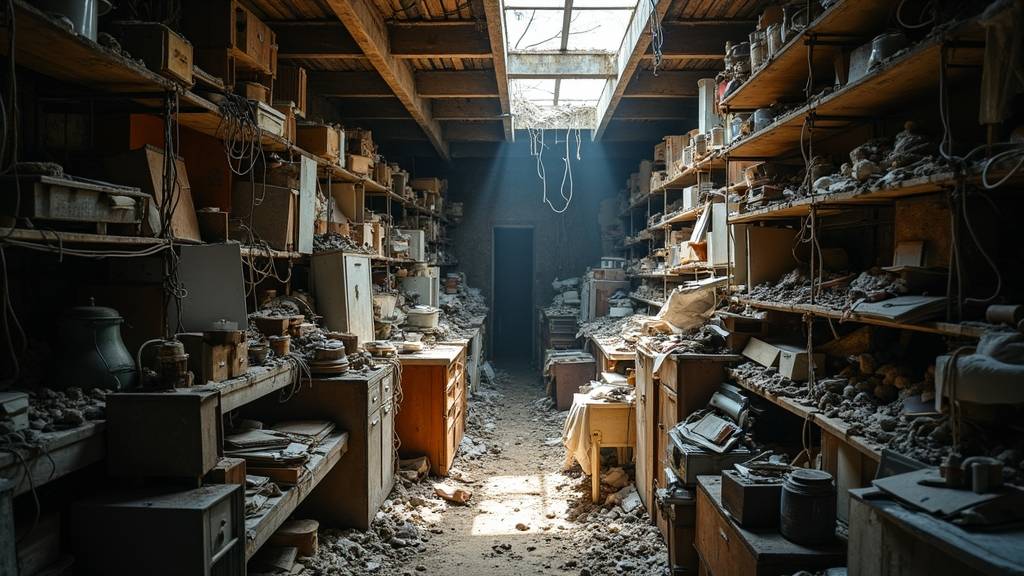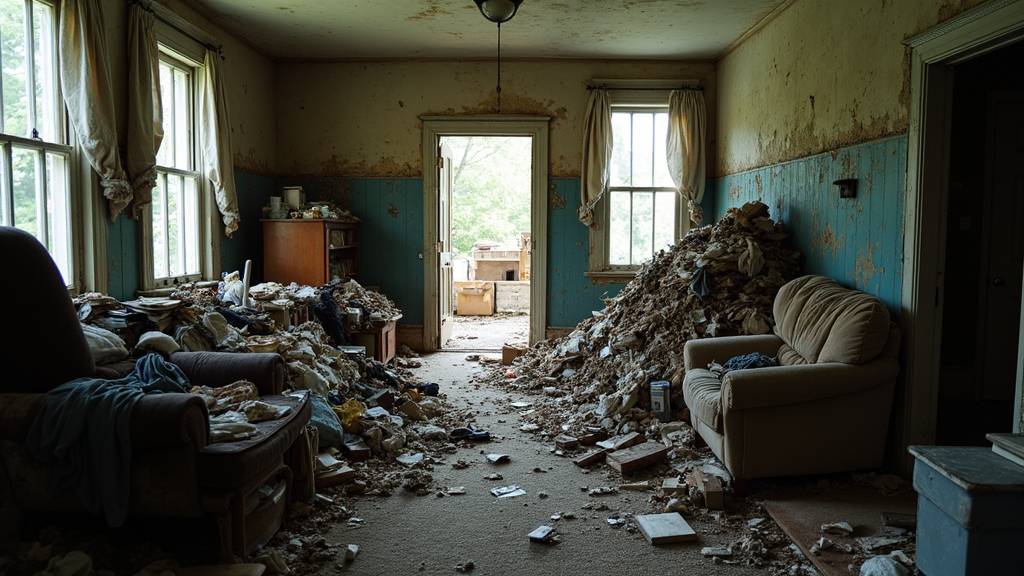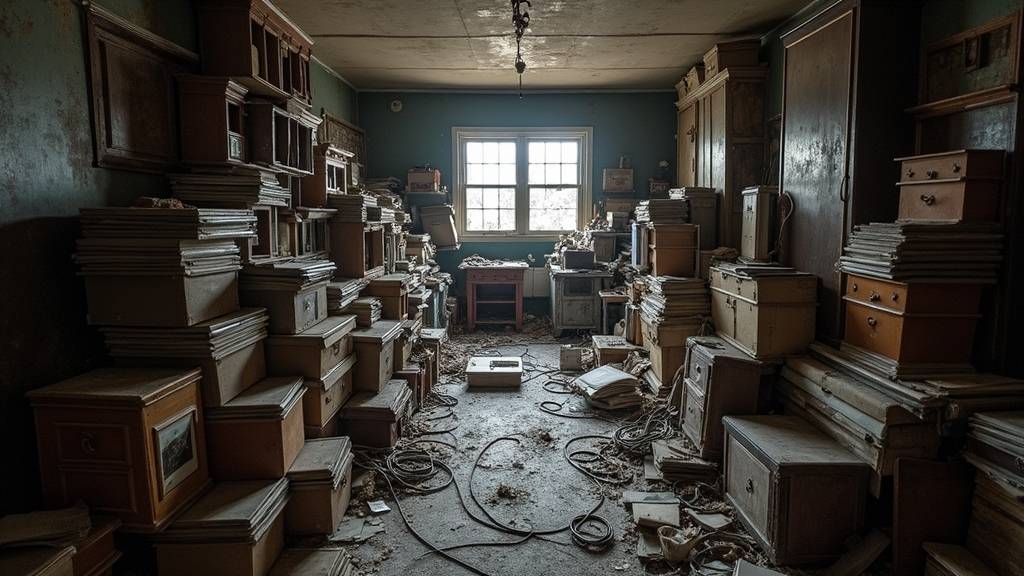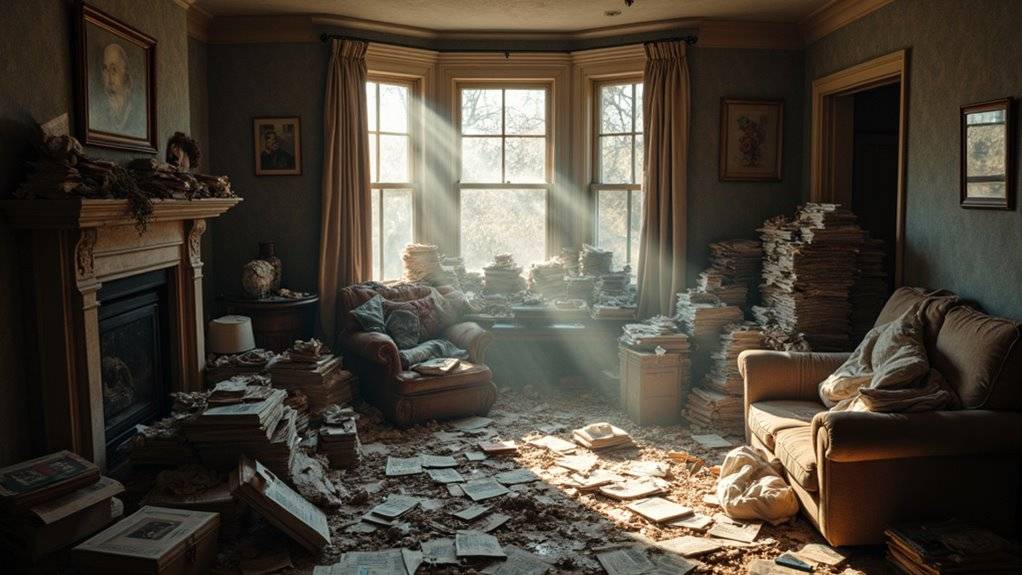Selling a hoarder house can be stressful. The mess and disrepair scare off many buyers. You may wonder if fixing it up is worth the time and money.
A hoarder house needs a lot of cleaning and repairs. Potential buyers often walk away because they cannot see the home’s true value. You risk a lower sale price if you skip renovations. You should renovate a hoarder house before selling if you want the best price and more interested buyers.
This blog will guide you through each step to make the process easier and more profitable. It will help you make smart decisions and avoid costly mistakes.
Key Takeaways
- Renovating a hoarder house increases buyer interest and sale price by improving appearance, safety, and marketability.
- Addressing major repairs and decluttering can reveal hidden damage, ensuring a smoother sale and fewer surprises during inspection.
- Professional cleanup and renovation costs can be significant, so weigh potential return on investment against local market trends.
- Selling as-is is faster but usually yields a lower sale price and attracts investors or cash buyers rather than traditional buyers.
- Consulting a real estate agent helps determine whether renovations or an as-is sale best fits your goals and the current market.
Understanding What Constitutes a Hoarder House

A hoarder house is more than just a messy or cluttered home. It is a place where too many items fill the rooms. The clutter makes it hard to move and live comfortably. Effortless Escrow Support can be especially helpful in navigating the process of selling such properties. If you look inside, you may not see any clear decorating style. Belongings pile up and cover original features and layouts.
People cannot enjoy or update the space easily. A hoarder house is not just about having old or mismatched furniture. It is about losing the sense of order in the home. If someone wants to restore such a house, it can be challenging but also rewarding. Understanding legal considerations involved in selling these properties can help ensure a smoother transaction.
Assessing the Extent of Clutter and Damage
To assess the extent of clutter and damage, examine each room carefully. Check how much clutter there is and look for any damage. Note if items block access or hide problems. If you find blocked hallways or doors, mark these as urgent issues. Damage to floors, walls, or fixtures under clutter should be recorded. If clutter hides problems, consider clearing it first. You can look for spaces where storage solutions could help.
If certain items can be organized or stored, list these options. Prioritize repairs and organization based on the home’s overall marketability. Additionally, understanding the home’s condition can help determine whether a renovation is worth the investment before selling. Recognizing the extent of damage can also influence your decision to renovate or sell as-is.
Health and Safety Risks Associated With Hoarder Homes

When you tackle a hoarder home, you’re facing more than just clutter—serious health and safety hazards come into play. Biohazards, mold, hidden structural damage, and pest infestations can threaten both your well-being and the property’s value. Addressing these risks upfront isn’t optional; it’s an essential part of asbestos management and safety protocols for renovation. Understanding the local real estate market can help you make informed decisions about whether renovation is worth the investment or if selling as-is is a better option.
Biohazard and Mold Exposure
Biohazard and mold exposure are common problems in hoarder homes. Clutter allows bacteria, pests, and mold to grow unnoticed. These hazards can make the air unsafe and cause health problems.
If you plan to sell or redesign your home, you must fix these issues first. Mold can hide behind walls or under flooring and may harm your lungs. Decomposing items and pests also create dangerous biohazards.
Dirty surfaces throughout the house will need deep cleaning. If you ignore these hazards, buyers may lose interest. Cleaning up biohazards and mold makes your home safer and more valuable.
Structural Damage Concerns
Structural damage in hoarder homes is a serious safety and health concern. It can be more dangerous than clutter. Problems like leaks or overloaded floors may go unnoticed for years.
If you skip a full inspection, you might miss rotten beams or hidden water damage. These issues can be expensive to fix and may scare off future buyers. Structural problems can also make renovation costs much higher.
Here are some hidden threats and their possible results:
| Hidden Threat | Potential Consequence |
|---|---|
| Collapsing Floors | Severe injury risk |
| Weak Foundations | Falling property value |
| Unstable Stairways | Legal liability |
If you plan to renovate or sell, always start with a structural inspection. This helps you find and fix the most dangerous problems first. Fixing these issues early protects both your safety and your investment.
Pest Infestation Risks
Pest infestations are a serious risk in hoarder homes. Clutter lets pests like rodents and cockroaches hide and multiply easily. These pests can go unnoticed for a long time.
Rodents and insects often chew through wires, which can cause fires. Pest droppings and dead insects can make the home unhealthy. Unsanitary conditions can also make it hard to sell the house.
If you find hidden nests, repairs and pest control may cost more. Addressing infestations early will protect your investment. A pest-free home will be more attractive to buyers.
Costs Involved in Cleaning and Decluttering

When tackling a hoarder house, you’ll face significant costs for both professional cleanup services and the actual disposal of unwanted items. It’s crucial to weigh these expenses, since specialized crews and dumping fees can quickly add up. By understanding these costs upfront, you can make smarter decisions and avoid unpleasant financial surprises during your renovation.
Additionally, considering the complexity of the cleanup process, consulting with local experts experienced in hoarder house cleanup can help provide accurate estimates and streamline the project. Engaging with trusted professional home buyers, like those at Freedom Path Investors, can also offer alternative solutions if a full renovation proves too costly or impractical.
Professional Cleanup Service Fees
Professional cleanup service fees can vary widely for hoarder homes. These fees usually start at a few thousand dollars and can exceed $10,000. Large homes or severe clutter increase the cost.
Cleanup services do more than basic cleaning. They remove debris, sanitize, and prepare your home for sale. Serious buyers are more likely to consider a clean property.
Several factors affect the total fee. Larger homes, more rooms, or hazardous waste raise costs. If you need the job done quickly, expect higher charges.
If you want to get the best price for your home, weigh these factors. Investing in professional services may help your property sell faster. In many cases, cleanup services increase your home’s value.
Disposal and Dumping Costs
Disposal and dumping costs are extra expenses you must plan for when cleaning out a hoarder house. Fees depend on how much or how heavy the trash is. These costs can increase fast if there is a lot to remove.
You may need to rent dumpsters or pay more for hazardous waste. If items have sentimental value, sorting them can take extra time. Sorting delays can cause your cleanup to take longer and cost more.
If you prepare for these costs, you can avoid surprises during your project. Careful planning helps you follow your budget and finish on time. Always factor in these costs before starting any cleanup or renovation.
Estimating Renovation Expenses
Accurate renovation cost estimates help you get the best price when selling a hoarder house. You should start by listing expenses for each room. Focus on kitchens and bathrooms, as they usually cost the most.
If you want to increase value, consider home staging and simple design updates. These improvements can boost buyer interest without much spending. Small changes often make a big difference.
You must check for structural, electrical, and plumbing problems first. Cosmetic updates like paint, new flooring, and lighting can offer high returns. If you need help, get quotes from contractors and designers. Additionally, understanding home repair costs can prevent unexpected expenses and help you allocate your budget wisely.
This method will help you avoid surprise costs and make smart investments. Careful planning attracts serious buyers and increases your chance of a good sale. Additionally, working with a trusted local business ensures a smooth and fair process from start to finish.
Evaluating Your Local Real Estate Market
Before you start renovations, assess your local real estate market to understand current demand and how similar homes are selling. Look closely at the condition of comparable properties and note what buyers actually want right now. By aligning your updates with these trends, you’ll maximize your investment and attract serious offers. Remember, capital gains tax considerations can influence your renovation decisions, especially if you plan to sell soon.
Current Market Demand
Current market demand shows if renovating a hoarder house is a good idea. You must check real estate trends in your area first. Demand affects how much work you need to do.
Buyers move quickly in a strong market. If homes sell fast, simple fixes and home staging might be enough. A slow market means buyers expect a finished, move-in ready house.
Review recent sales data to see how long homes stay listed. Compare prices for renovated homes and those sold as-is. Real estate agents can share what buyers want in your neighborhood.
Let local demand shape your renovation plan. If demand drops, more upgrades may be needed to attract buyers. Always base your renovation choices on current market trends.
Comparable Property Conditions
You need to compare your hoarder house with similar homes in your area. Look at recent sales and active listings with similar size, age, and location. This helps you understand how your property measures up.
Check the features of these homes, such as kitchen upgrades, fresh paint, and neat yards. If most homes have these updates, your house may need similar changes to attract buyers. Consider making improvements if your property is outdated.
Use the table below to compare your house with others nearby. This will help you decide which renovations are necessary. Data-driven choices can help you compete in the market.
| Feature | Your Hoarder House | Comparable Homes |
|---|---|---|
| Decorative Finishes | Outdated/Minimal | Modern/Upgraded |
| Landscaping Enhancements | Neglected/Overgrown | Well-maintained |
| Overall Cleanliness | Needs Deep Cleaning | Move-in Ready |
Buyer Preferences Trends
Local buyer trends directly influence your renovation strategy. You should understand what buyers want before spending money on updates. Buyer preferences can change what features add value.
If buyers in your area want move-in ready homes, focus on cleaning and modern design. A staged home with updated kitchens and bathrooms often attracts more interest. Neutral paint and simple décor appeal to most buyers.
Some markets prefer homes that need work. In these cases, it makes sense to do only essential repairs. You can save money if demand is strong for fixer-uppers.
Modern features like smart thermostats or updated lighting can stand out. If buyers seek these touches, consider adding them. Always study recent sales and listings to spot these trends.
Potential Return on Investment From Renovations
Renovating a hoarder house before selling can increase your return on investment. Clean and updated homes often sell for higher prices. If you improve the house, buyers may see more value and offer more money.
Simple changes like decluttering, repainting, and fixing broken items help the home look better. Landscaping, such as mowing the lawn and planting flowers, can improve curb appeal. These updates usually attract more buyers and higher offers.
If you spend money on strategic renovations, you can make the property more competitive. Each dollar you invest can help increase your final profit. Selling a well-presented home is usually easier and more profitable.
Additionally, understanding the local real estate market can help you determine which renovations will give you the best return. Knowing how to sell your house fast without fees can also make the process more efficient and less stressful for you.
Impact on Buyer Pool and Marketability
Renovating a hoarder house increases the number of people interested in buying it. A clean and organized space appeals to more buyers and makes the home easier to sell. If you address the clutter, the house stands out better in the market.
Removing clutter takes away the negative image often linked with hoarder homes. Buyers find it easier to see the true value of the property. If the house looks well-kept, buyers may make faster and better offers.
Solving storage issues makes the home more practical for families and individuals. People looking for a move-in ready house will show more interest. Renovations help buyers picture their own lives in the space.
If emotional traces are removed, buyers can connect with the house on their own terms. This creates a neutral space that welcomes new owners. Renovating changes how buyers see the property and can lead to a quicker sale.
Additionally, addressing underlying issues such as foundation problems can further improve marketability and buyer confidence.
Legal and Disclosure Obligations
You must tell buyers about a hoarder house’s past and any problems that could affect their choice. This is a legal requirement and is not optional. Disclosure protects you from future problems and helps buyers understand what they are getting.
If the home has mold, pests, or bad smells, you must clearly share this information. Some issues may remain even after repairs. Buyers need to know these facts so they can make informed decisions.
Environmental hazards can cause health risks and may need fixing. Structural issues can lower the home’s value and affect price talks. The home’s hoarding history may make buyers less trusting or change their view of the property.
Being honest about these facts helps you meet the law and build trust. If you are upfront, the sale process may go more smoothly. Always keep records of what you disclose to protect yourself. Additionally, proper disclosure includes full documentation of any past issues to avoid legal complications later.
Timeframe Considerations for Renovation vs. Selling As-Is
When deciding between renovating or selling your hoarder house as-is, you need to weigh how long each option will take. Renovation projects can stretch for months, potentially missing the best window to list your property, while selling as-is—especially to cash buyers—often means a much faster closing. By understanding how timing affects your bottom line, you can choose the approach that aligns with your goals.
Project Timeline Expectations
Renovating a hoarder house takes much longer than selling it as-is. Renovation requires deep cleaning, repairs, and upgrades. This process can last several weeks or months.
If you want to get the highest price, you may need to stage the home and improve curb appeal. These extra steps can add several more days. Home staging helps attract more buyers.
Selling the house as-is usually moves faster. Most as-is sales close within a few weeks. If you need a quick sale, this option may suit you better.
If you have time and want a higher sale price, choose renovation. If you need to sell quickly, consider selling as-is. Your decision depends on your timeline and goals.
Market Timing Impact
Market timing affects your home sale outcome. Selling during a strong market can mean higher prices and faster offers. If you delay for renovations during a peak, you might miss the best window.
If you sell without fixing up and demand is low, your house could sit on the market longer. This often leads to lower offers. Local trends like rising prices or low inventory can influence your decision.
You should compare the benefits of updates against current market conditions. If you plan carefully, you can avoid losing money due to poor timing. Strategic timing helps you get the best possible return.
Speed of Cash Sales
Cash sales are much faster than selling after renovations. If you need to sell quickly, cash buyers are often the best choice. They can close a sale in just a few days.
The process skips listing, staging, and long negotiations. Sellers do not have to wait for buyers to get loans. There is no need to wait for renovation permits or inspections.
If you want to avoid ongoing costs, cash sales offer immediate relief. Owners can move on without worrying about repairs or cleaning. This option may be better than trying to increase value with upgrades.
Working With Real Estate Agents Experienced in Hoarder Properties
Working with real estate agents who have experience with hoarder properties is very helpful. These agents know the unique problems that come with selling these homes. They can guide you through the process from start to finish.
An experienced agent will check the amount of clutter and any damage. If the home cannot be shown with open houses, the agent may suggest virtual tours. This helps protect your privacy and makes buyers feel more comfortable. A skilled agent can assess clutter and damage, and may use virtual tours to ensure privacy and ease for potential buyers.
Agents who work with hoarder homes often know good cleaning crews and repair workers. They can connect you with these services if needed. This makes it easier to fix up the home before selling.
If you hire the right agent, you can attract buyers who are ready for a renovation project. These buyers can see the home’s true potential. This increases your chances of a smooth and successful sale.
Options for Selling Without Renovations
You can sell a hoarder house without making renovations. Some buyers will accept homes in poor condition if the price is fair. Listing the home honestly helps attract serious buyers.
Sellers should use simple staging to make the house look organized. Clearing walkways and showing each room’s purpose can help buyers see value. These steps can make the property more appealing.
Virtual tours are useful if you want to reach more buyers. Out-of-town buyers or those with busy schedules may rely on these tours. Detailed videos allow buyers to view the property before visiting in person.
Setting a competitive price is important if the home needs work. The price should match the home’s current condition. This approach can increase buyer interest without spending on renovations.
Pros and Cons of Selling to Investors or Cash Buyers
Selling to investors or cash buyers is a fast way to sell a hoarder house. These buyers usually take homes “as-is,” so you do not need to clean or fix anything first. They handle the problems and close the deal quickly.
If you choose this option, you may get less money than selling on the open market. Investors often pay less because they will pay for repairs and cleanup themselves. This could affect your final profit from the sale.
Some sellers may find this process emotionally difficult, especially if the home has family memories. Selling quickly without making improvements can feel sudden. You should think about your feelings and financial needs before deciding.
Deciding What Makes the Most Financial Sense
To find the best way to sell a hoarder house, first look at possible profit and total costs. A property appraisal gives you a clear idea of its market value. This helps you make the right financial choice.
Start by weighing potential profit and all costs—an appraisal will clarify your hoarder house’s true market value and guide your decision.
You should include the price of repairs, cleaning, and junk removal in your calculations. Zoning rules may limit what changes are allowed on the property. If upgrades are not allowed, spending money on them may not help.
If you renovate, compare the cost to the likely increase in sale price. Selling as-is might bring less money but can save on expenses. Consider both options before making a decision.
A careful review can help you avoid spending too much. The right choice should bring the best return with the least risk. If you are unsure, ask a real estate expert for advice.
Conclusion
If you need to decide whether to renovate a hoarder house before selling, consider your goals and resources. Renovating can increase a home’s value, but it requires significant time and investment. If you want a quicker solution, selling as-is may be more practical.
If you choose not to renovate, companies like ours can help. We buy houses for cash, no matter the condition. This option can save you time and reduce the stress of repairs and cleaning.
If you are ready to move forward, Freedom Path Investors is here to assist. We make fair, fast offers and handle all the details. Contact us today to see how we can help you sell your hoarder house quickly.







